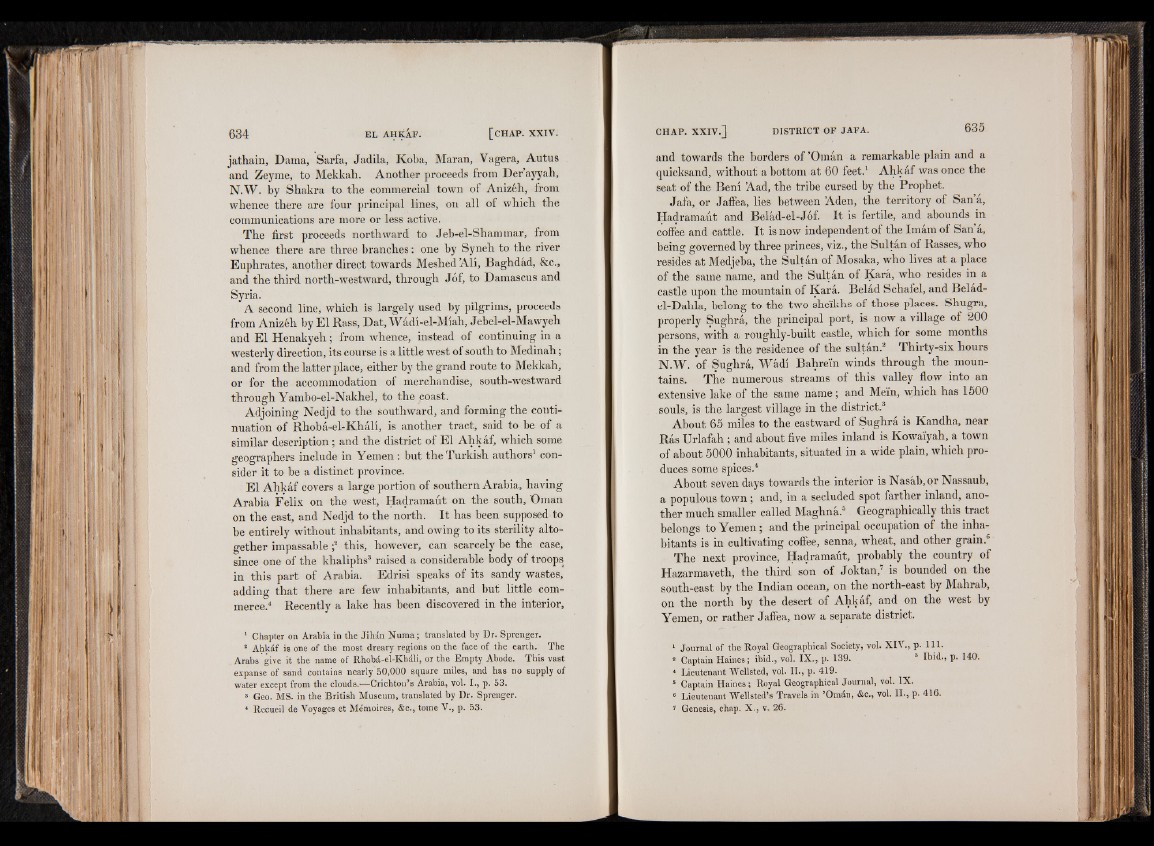
jathain, Dama, Sarfa, Jadila, Koba, Maran, Vagera, Autus
and Zeyme, to Mekkah. Another proceeds from Der’ayyah,
N.W. by Shakra to the commercial town of Anizéh, from
whence there are four principal lines, 011 all of which the
communications are more or less active.
The first proceeds northward to Jeb-el-Shaminar, from
whence there are three branches : one by Syneh to the river
Euphrates, another direct towards Meshed Ali, Baghdad, &c.,
and the third north-westward, through Jof, to Damascus and
Syria.
A second line, which is largely used by pilgrims, proceeds
from Anizéh by El Rass, Dat, Wadi-el-Miah, Jebel-el-Mawyeh
and El Henakyeh ; from whence, instead of continuing in a
westerly direction, its course is a little west of south to Medinah ;
and from the latter place, either by the grand route to Mekkah,
or for the accommodation of merchandise, south-westward
through Yambo-el-Nakhel, to the coast.
Adjoining Nedjd to the southward, and forming the continuation
of Rhoba-el-Khali, is another tract, said to be of a
similar description ; and the district of El Ahkâf, which some
geographers include in Yemen : but the Turkish authors1 consider
it to be a distinct province.
El Ahkâf covers a large portion of southern Arabia, having
Arabia Felix on the west, Hadramaut on the south, ’Oman
on the east, and Nedjd to the north. It has been supposed to
be entirely without inhabitants, and owing to its sterility altogether
impassable ;2 this, however, can scarcely be the case,
since one of the khaliphs3 raised a considerable body of troops
in this part of Arabia. Edrisi speaks of its sandy wastes,
adding that there are few inhabitants, and but little commerce.
4 Recently a lake has been discovered in the interior,
1 Chapter on Arabia in the Jihân Nuraa; translated by Dr. Sprenger.
! Ahkâf is one of the most dreary regions on the face of the earth.' The
Arabs give it the name of Rhobâ-el-Khâli, or the Empty Abode. This vast
expanse of sand contains nearly 50,000 square miles, and has no supply of
water except from the clouds.—Crichton’s Arabia, vol. I | p. 53.
3 Geo. MS. in the British Museum, translated by Dr. Sprenger.
4 Recueil de Voyages et Mémoires, &c., tome V., p. 53.
and towards the borders of ’Omán a remarkable plain and a
quicksand, without a bottom at 60 feet.1 Ahkáf was once the
seat of the Beni Aad, the tribe cursed by the Prophet.
Jafa, or Jaffea, lies between Aden, the territory of San a,
Hadramaut and Belád-el-Jóf. It is fertile, and abounds in
coffee and cattle. It is now independent of the Imam of San a,
being governed by three princes, viz., the Sultán of Rasses, who
resides at Medjeba, the Sultán of Mosaka, who lives at a place
of the saíne name, and the Sultan of Kara, who resides in a
castle upon the mountain of Kará. Belad Schafel, and Belad-
el-Dahla, belong to the two sheikhs of those places. Shugra,
properly Sughrá, the principal port, is now a village of 200
persons, with a roughly-built castle, which for some months
in the year is the residence of the sultán.2 Thirty-six hours
N.W. of Sughrá, Wádí Bahrein winds through the mountains.
The numerous streams of this valley flow into an
extensive lake of the same name; and Me'in, which has 1500
souls, is the largest village in the district.3
About 65 miles to the eastward of Sughrá is Kandha, near
Rás Urlafah ; and about five miles inland is.Kowaiyah, a town
of about 5000 inhabitants, situated in a wide plain, which produces
some spices.4
About seven days towards the interior is Nasab,or Nassaub,
a populous town; and, in a secluded spot farther inland, another
much smaller called Maghna.5 Geographically this tract
belongs to Yemen; and the principal occupation of the inhabitants
is in cultivating coffee, senna, wheat, and other grain.6
The next province, Hadramaut, probably the country of
Hazarmaveth, the third son of Jok tan,7 is bounded on the
south-east by the Indian ocean, on the north-east by Mahrab,
on the north by the desert of Ahkáf, and on the west by
Yemen, or rather Jaffea, now a separate district.
1 Journal of the Royal Geographical Society, vol. XIV., p. 111.
8 Captain Haines; ibid., vol. IX., p. 139. 3 Ibid., p. 140.
4 Lieutenant Wellsted, vol. II., p. 419.
3 Captain Haines ; Royal Geographical Journal, vol. IX.
6 Lieutenant Wellsted’s Travels in ’Omán, &c., vol. II., p. 416.
1 Genesis, chap. X., v. 26.